by Jeanne Allen
Download or print your PDF copy here.
Preamble: A Movement at Risk

This is a clarion call.
Some 40 years ago, A Nation at Risk called the American public to arms, impressing on them the urgent need to refocus on a robust education for our nation’s youth:
“If an unfriendly foreign power had attempted to impose on America the mediocre educational performance that exists today, we might well have viewed it as an act of war. As it stands, we have allowed this to happen to ourselves … We have, in effect, been committing an act of unthinking, unilateral educational disarmament. [We can] reverse the current declining trend — a trend that stems more from weakness of purpose, confusion of vision, underuse of talent and lack of leadership than from conditions beyond our control.”[1]Preview Changes
Nearly half a century later, a wave of amnesia has taken hold of American minds. Many have forgotten, or never knew, what this report’s message was and why it was so impactful. It was bipartisan, diverse, and it produced a generational commitment to education reform that has endured. Until now.
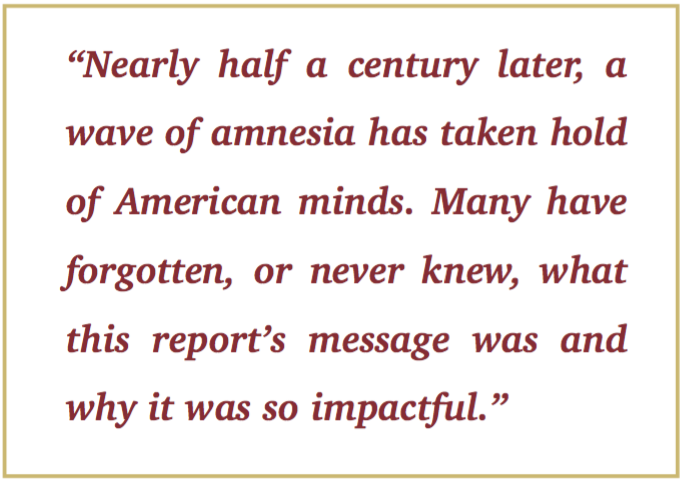
Dr. Milton Goldberg was the Executive Director of the National Commission on Education Excellence at the time of A Nation at Risk’s release. The consensus of some 65 different commission members was historic. He explains: “They agreed to disagree. They agreed to set aside major disagreements and agree on the things that they believed were absolutely crucial. What was crucial? Crucial was making sure that every high school youngster graduates with a solid curriculum of what we call the basics …that every teacher ought to be fully qualified.”[2]
The result was a unified challenge to the nation, a president who attended 51 education meetings around the country in one year and a decade of subsequent commission reports, convenings and goals statements. Governors took up the flag and ushered in a bevy of reforms that challenged the status quo. A Nation at Risk reminded us of an educational tradition that Alexis de Toqueville argued made us distinctively enterprising, and entirely practical.
Between 1991 and 2000 alone, 36 laws were enacted governing the creation of new charter schools and two created new full school choice programs.[3] States also enacted their own standards for the first time, began high stakes exit testing, initiated merit pay and decentralized educational decisions during that period. Clearly from the 90s and into the early 2000s, the national mood was in reform’s favor. And the result was the development of a movement of thousands of people, organizations, policymakers and pundits engaging with and for great education.
By 2008, the unity and the results were both dwindling. The American people were upset about wars and political battles. It was as if the terrorist threat didn’t just change our way of life externally, but also our ability to unite over important domestic issues, indeed, the most important domestic issue of our time. As Dr. Goldberg explained, the people who issued A Nation at Risk “saw the link between well-educated people and a citizenry that knows how to deal with security and economic stability.”[4]
We must connect these dots as well.
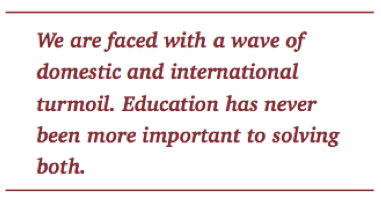
We are faced with a wave of domestic and international turmoil. Education has never been more important to solving both.
And yet the movement to ensure educational attainment for all is at a crossroads. We are losing ground in part because we are losing the argument. And our hopes of systemic change — our progress — will be lost, and we will be a nation at even greater risk, if we do not refocus our collective energies and message to connect with the broad universe of education consumers and citizens everywhere.
We are at a crossroads. A decision must be made. A path must be chosen.
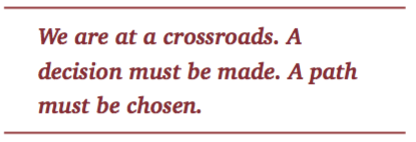
Where We Are
It shouldn’t take a hurricane. But sometimes it takes a tragedy to help remind us what’s important — and not to take it for granted. Nowhere is this more obvious for the education reform movement than looking at New Orleans. In 2005, Hurricane Katrina washed away much of the city’s education infrastructure. In the wake of the widespread destruction of property and the massive exodus of people, the state of Louisiana, with the help of education reformers, created autonomous charter schools to fill the void.
 Before Hurricane Katrina, 62% of the city’s students were enrolled in failing schools and half didn’t graduate from high school. But today three quarters of kids are graduating on time and the percentage of students testing at grade level has gone up by 77%.[5] More than 90% are enrolled in charter schools.[6] Meanwhile the Louisiana Scholarship program gives a voucher to more than 7,000 students who are enrolled in low-performing public schools to attend a parochial or a private one. In 2015, 12,000 students applied for those slots, which is not surprising since the academic gains outpaced the majority of districts in the state. [7]
Before Hurricane Katrina, 62% of the city’s students were enrolled in failing schools and half didn’t graduate from high school. But today three quarters of kids are graduating on time and the percentage of students testing at grade level has gone up by 77%.[5] More than 90% are enrolled in charter schools.[6] Meanwhile the Louisiana Scholarship program gives a voucher to more than 7,000 students who are enrolled in low-performing public schools to attend a parochial or a private one. In 2015, 12,000 students applied for those slots, which is not surprising since the academic gains outpaced the majority of districts in the state. [7]
For education reformers — the people who dreamed of remaking not only schools, but reimagining school districts and entire education systems — New Orleans reminds us what is possible. Parents, regardless of their means and their zip code, are finally getting to choose what’s best for their children. Those who find that their kids are not performing well, or simply that a school is not the right fit for their child, can change. The best schools earn popularity and students as well as parent loyalty and money. The fact that schools have autonomy and parents have choices has helped to make the entire city a hotbed of innovation—from teacher training to curriculum to the use of technology in the classroom.
This is the closest we have come to realizing the groundbreaking vision of education innovator Ted Kolderie, who first wrote about the critical nature of breaking the exclusive franchise of traditional school districts holding parents captive based on zoned attendance.
At that time — a full 25 years ago — few imagined his prescription for creating new, responsive schools in the spirit of choice, innovation, and diversity would evolve into a nationwide movement. Describing the passage of Minnesota’s original charter law back in 1991, former state senator and bill author Ember Reichgott Junge explains, “Chartering trades regulation for results, bureaucracy for accountability, and we weren’t used to doing things like that. Resistance came from everywhere.”[8]

Thanks to the moral leadership of national advocates like Howard Fuller, and the hard work of thousands too numerous to mention, the signs of success are everywhere. This year, there are 6,700 public charter schools enrolling over 2.5 million students across the country in 43 states, and parents’ rights to choose myriad alternatives are in effect in all but a few.[9] Charter schools are no longer a marginal experiment in U.S. education. In more than a dozen cities, charter schools educate 30% of or more of all public school students, and are creating a ripple effect uplifting entire education systems, and seating supportive education leaders who helped create alternative opportunities in positions of authority at local and state levels.[10]
And yet, if we as a movement are to be honest with ourselves, we must acknowledge that our efforts to drive change have a hit a wall. The reality is that more was accomplished in the first nine years of the education reform movement than in the past 16.
Of the 13 strongest charter laws, 12 were passed between 1991 and 1999, and it is these 12 states alone that account for over 56% of existing charter schools.[11] Only nine states passed a charter law between 2000 and 2015, and they opened a combined total of 233 schools, serving so few students that their impact on a national scale is almost negligible.[12] Unlike the early laws in Michigan and Washington D.C., that championed operational and authorizer autonomy with sweeping statewide implementation, the recent laws in Mississippi, Washington State and Alabama are mired in limitations on their flexibility and squashing student potential.

Such programs have not escaped political backlash either.
There was a time when Hillary Clinton, for example, supported substantive changes to the status quo. In 1996, she wrote in her book It Takes A Village that she “[found] [the charter school] argument persuasive,” at least — and was in favor, and would have purportedly been in favor of pro-charter policies her husband, the former President Clinton put forward, including legislation he said would put the nation “well on [its] way to creating 3,000 charter schools by the year 2000.”[13] But spring forward to November 2015, when she parroted the opposition’s lines. “Most charter schools — I don’t want to say every one — but most charter schools, they don’t take the hardest-to-teach kids, or, if they do, they don’t keep them,” Clinton said.[14]
By contrast, she said, traditional public schools “thankfully, take everybody, and then they don’t get the resources or the help and support that they need to be able to take care of every child’s education.”[15]
In New York, decades of public school choice efforts followed by expansive charter school and accountability efforts under Mayor Bloomberg’s tenure made the Big Apple’s school system one of the nation’s models for how to transform both schools and the communities they serve. Yet, despite substantial student achievement gains,[16] Mayor de Blasio has been emboldened overall and in the charter sector in particular. Mayor de Blasio came into office hellbent on rolling back the entire Bloomberg agenda, watering down accountability systems, and handing control of City schools back to the self-interested forces that held them back in the first place. Most notably, the Mayor decided as one of his first acts to declare war on the charter sector in general and the wildly successful network of Success Academy schools, which was thankfully thwarted by the combined strength of Governor Cuomo and New York’s passionate charter parents. Still, every day the de Blasio Administration does what it can to impede the progress and growth of the charter school through bureaucratic tactics.[17]
Perhaps the most troubling sign of reform’s place in the debate is the sudden unraveling of the New Orleans revolution. Instead of being feted and replicated, the path breaking and life-changing Recovery School District is being assaulted from all sides by the opponents of change. Charter school leaders must spend a significant portion of every day defending their success against legislative bills masquerading as attempts to hold them accountable.
As the Times Picayune editorialized, “20 years after Louisiana’s first charter school opened, you’d think the state’s educational establishment would’ve accepted the independence and innovation charters represent. But judging by the slew of legislation filed this year to curb the growth of charters, that isn’t the case. There are bills to limit the state Board of Elementary and Secondary Education’s power to grant charters, to take funding away from charters and to forbid charter boards from contracting with for-profit operators.”[18]
Even worse, in the name of “local control” the fate of the charter sector is about to be put in the hands of an institution — the school board — which historically opposes giving any power to schools and autonomy to individual school leaders. This is the same structure, by the way, which doomed New Orleans students to violent and chronically failing schools before Katrina.
The situation is similar in Washington, DC, where more than 46% of all students attend a charter school and other improvements in the breadth and depth of opportunity for students were adopted with bipartisan support.[19] The substantive change was a result of a continual give and take among political, business and education reform advocates that came together to remake one of the worst systems in the country. Double-digit gains in math and reading over a sustained period show the District’s success above and beyond all but a handful of states. It was the direct result of the competitive pressure infused into a system that had long — and incorrectly — accepted poverty as an excuse for failure, and took the task seriously of reinventing all educational offerings with rich and varied new approaches and content to drive them.
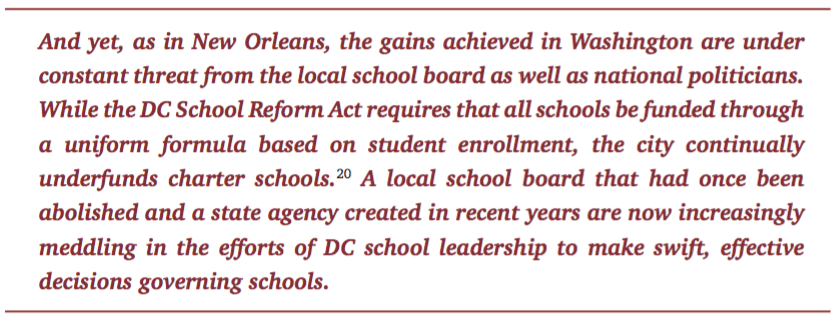
In no small part due to the educational revolution the city has experienced, Washington’s business, economic and social landscape was transformed. Where once it was unsafe to roam outside of a few limited commercial and government sections, today the District of Columbia is one of the most desirable cities in the nation to live and work, drawing diverse communities of people fighting over real estate, office space and schools.
And yet, as in New Orleans, the gains achieved in Washington are under constant threat from the local school board as well as national politicians. While the DC School Reform Act requires that all schools be funded through a uniform formula based on student enrollment, the city continually underfunds charter schools.[20] A local school board that had once been abolished and a state agency created in recent years are now increasingly meddling in the efforts of DC school leadership to make swift, effective decisions governing schools.
These moves are most often well intentioned, though their proponents fail to understand why and how the governance changes were made to begin with. And the political will allocated for such misguided efforts could be used instead to further empower teachers and administrators to lead innovations in teaching and learning.
The same kind of distractions from the business at hand must be said of the Common Core State Standards debate, which has drained our collective energies and focus on students. Opponents rarely took time to understand how the standards were adopted, why and how they were being used, and what they actually said, while proponents regularly dismissed concerns without examining their cause or intent, resulting in a more fractured community of once powerful advocates, whose alignment on issues such as opportunity and innovation is now secondary.
This is where we stand on the cusp of an important election: off message, losing ground at the national level, losing fights in communities across the country, and struggling to hold on even in the places where we have demonstrated the most dramatic success.
It is tempting to attribute this troubling trend line as a natural reaction to our successes, a sign of growing pains. The enemies of change, those most invested in the status quo, are clearly threatened, and they are fighting back with everything they have. We have heard this from many of our allies, and there’s certainly some truth to it. States such as Nebraska, have tried for a decade to enact a charter law but no bills make it the floor.[21] Inertia, ignorance about outcomes, and a powerful teachers’ association are all part of the story here.
It is also clear that the national political environment and the deepening distrust of government and other large institutions is playing a role one that until only recently simmered under the surface. Witness the rapid reversal of the Republican Party’s commitment to reform in the wake of the Tea Party movement’s rise. A dozen years after standing with President George W. Bush to issue in a new era of federal accountability with the passage of No Child Left Behind, conservatives in the House and Senate removed substantive federal carrots and sticks that were credited with shining a spotlight on the “soft bigotry of low expectations.”[22]
Despite historic Republican support for standards, local school board and state agencies are once again in the drivers’ seat for reform without any mandate from Washington. While this sounds rational to people who believe in our founding principles that “government which governs least governs best” it raises issues as to precisely how institutions that once caused a nation a risk can now drive student proficiency beyond 40%.[23] The new NCLB, the Every Student Success Act, therefore poses challenges, as well as opportunities.
But reformers have become our own worst enemy. What started out as an agenda that was bold and all encompassing has turned into something that too often comes across as narrow, hollow, and hostile to the idea and ideals of public education. Our movement has become known more for what it is against than for what it advocates.
It’s true, as some of our allies will point out, we continue to experience isolated victories. A state guided, bipartisan effort to save Camden, New Jersey, from educational failure is slowly seeing signs of progress. Courts continue to rule in favor of school choice programs, as North Carolina’s Supreme Court ruled in favor of its relatively new and oversubscribed Opportunity Scholarship Program.[24] In Washington State, charter schools that were in danger of becoming nonexistent following a State Supreme Court ruling will become charters again this fall courtesy of a new law.[25] And despite the heightened war on charters, polling suggests charters remain relatively popular — that is, in theory and in limited, urban practice.[26]
But once you broaden the focus, it’s clear the education reform movement is losing ground. Even with a Democratic president who strongly supports the charter model, and congressional leadership pre-disposed to choice and innovation; even with more money and muscle behind our movement than ever before, efforts to expand innovation and opportunity in states that already allow both, or to seed new schooling innovations to suburban areas have been roundly routed across the country. We have managed to convince the larger universe of parents that good charters are only for poor children, but of little relevance to suburban communities.
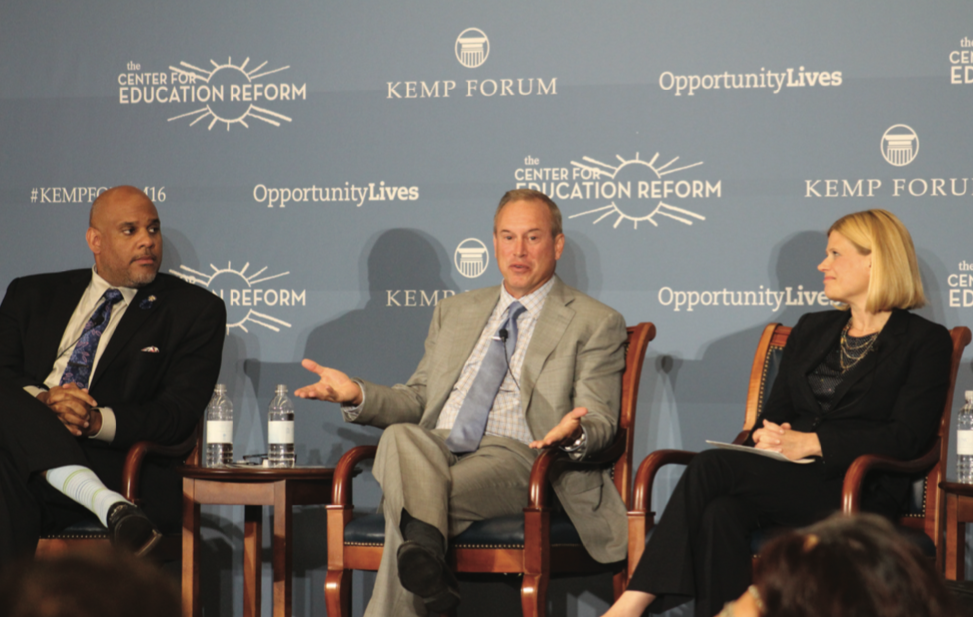
Campaigns to strengthen state laws (to lift caps, increase funding, remove roadblocks to innovation) or to fight them being weakened are failing more often than winning. In Massachusetts, 34,000 children remain stranded on waitlists for charter schools while the state legislature continues to ignore the demonstrated wishes of their constituents, forcing the question of access to high quality schools to a ballot question this fall.[27] Across the country, programs that could be replicated and benefit thousands of children — are being stunted at best and snuffed out at worst.
Consider:
New Country School in Minnesota was one of the first five charter schools to open in the nation. Focused on the environment and experiential learning, New Country made national headlines in its early years for discovering the mutant tadpoles caused by polluted rainwater. Overwhelmingly popular with parents and students, the school is given a four out of a 10 on the Great Schools website. Why? Because its approach and benefits are not readily assessed by mile-wide, inch-deep state (or national) standards that are limited to reading comprehension and math. The result is that Minnesota policymakers are constantly being asked to close such schools.
The Maine Academy of Natural Sciences exposes students to several hundred acres of wilderness to promote their interests and further potential careers in farming, forestry, and sustainability. Some students do not read proficiently by state standards, but achieve greatness in numeracy and science. Though the academy receives only 60% of the state’s average funding to achieve these results, it is under attack.
Laws that inhibit this kind of innovation are spreading. New Mexico’s charter law reads that: “Annual performance targets shall be set by each chartering authority in consultation with its charter schools and shall be designed to help each charter school meet applicable federal, state and chartering authority expectations as set forth in the charter contracts to which the authority is a party.”[28] Amazingly, charters, which were supposed to have greater freedom and autonomy, now seem to have more burdensome regulations to meet than their traditional school counterparts.
Idaho’s charter law says, “No whole school district may be converted to a charter district or any configuration which includes all schools as public charter schools.” It also restricts school boards from approving virtual schools and dictates certain processes by which such online schools will conduct professional development, teacher-student interaction, and technical support.[29]

In New Jersey, charters must abide all the rules and regulations that other public schools follow unless they receive a waiver, and no public funds can be used to construct them.[30]
In Tennessee, all contracts over $10,000 must be bid out (as if there’s a connection between student achievement and contracting) and no tax-paying company may be contracted to manage a school (as if tax status were an indicator of program quality).[31]
Finally, in North Carolina, the education department oversees entirely the creation and maintenance of charter schools, thanks to a law backed by charter school advocates.[32] The same state has made digital learning a priority, wiring schools, and inviting ed-tech companies to help with advances in teaching and learning, but it won’t allow for the most basic innovation — changing how schools are run.
One of the most path-breaking attempts to reward teacher performance, and thus attract and retain the best and brightest for our kids, is the DC Impact system, which was the culmination of a tough but brilliant consensus between union and DC leadership.[33] The system is now going to revamp teacher evaluations, removing the third party evaluator and instead placing control in the hands of principals whose own skills and abilities are often sorely lacking.
These regulations are not much different from the kind imposed on traditional schools that the earliest reformers fought to change. As long as schools were required to provide a certain number of years of a subject matter, a certain number of days of teacher training, a certain number of kids in the classroom, the bureaucracy was content. Inputs, however, have never driven outcomes in education without clear incentives and flexibility.
Collectively, these regressions in law, policy, and practice are stifling the ability for innovative approaches and learning opportunities to continue what once seemed to be an exponential growth curve. The demand for Teach for America graduates is waning, the demand for more education technologies blended into the work is losing steam, and the growth rate of charter schools in this nation has dropped from roughly 13% every year to 8%.[34]
So what happened?
The truth is, we have lost the change-forest for the choice-trees, too often pushing charters and vouchers as an end in and of themselves rather than a means to spur innovation and opportunity and ultimately deliver on the promise of a great education for all children. We have spent so much time talking about what’s wrong with our schools, and fighting for alternatives to it, that we have understandably left too many parents with the impression that we have given up on public education — or even worse, their kids.
The best evidence of this is the evolution of the strategy and tactics our opponents have used against us. A decade ago we had them pinned under the weight of the incontrovertible evidence of the achievement gap and their resistance to any meaningful change. They were the party of no. But after spending millions of dollars on polling, testing, and training, the defenders of the indefensible found a way to turn the tables by turning our rhetoric against us, relentlessly portraying the reform movement as rich, separatist corporatists who want to privatize our public schools.
It’s an ugly, phony caricature, but sadly it’s one we have been complicit in creating. While our movement’s ranks have grown far more diverse and representative of the great American melting pot, our leadership and public face remains far too white and wealthy, dominated by Walmart and Wall Street, though in reality the grassroots of reform is just the opposite. It’s a problem we, as a community, are aware of and concerned about, but we have inexplicably failed to act.
Now that we are on the defensive, we have been caught in a vicious cycle of concession and capitulation. We attribute much of this to the fact that full-time advocates are outnumbered. But the odds used to be worse. Our message back then was education of all constituencies, at all levels combined with a willingness to engage directly with those who may oppose our efforts, but are not the enemy.
How do we reconnect with our original mission and our initial successful strategies?
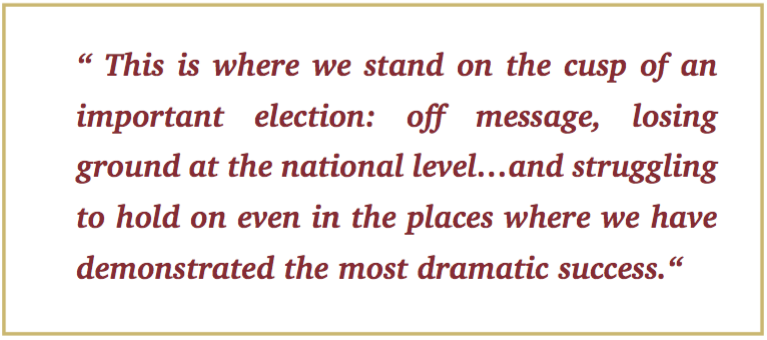
Where We Need to Be
How do we get back to being big, bold and holistic? How do we make the New Orleans revolution into the new baseline of normal, rather than a fleeting memory?
We must start by resetting our perspective about the difference between means and ends. As Howard Fuller recently admonished, “We ought to be impatient because we have not made the changes in education that we need to make. The movement’s soul is not about new school models or pedagogy or standards or technology. It’s about our children’s lives.”
Why did we embrace charters in the first place as a vehicle for improving children’s lives? Here we can and should take inspiration and guidance from another of our founding fathers, Ted Kolderie.

Charters were intended, explains Kolderie, to “differ in fundamental ways from the district sector” with four important elements:
- Innovation from the standard model
- Accountability, operating as outcome based not process driven
- Autonomy to avoid bureaucracy
- Choice, “on the theory that we do not assign people to innovations.”[35]
Kolderie argues most recently in his book, “The Split Screen Strategy: Improvement + Innovation,” that we must have a chartered sector that is open to innovation not only for the sake of those schools but also to serve as the seedbed for new models of schools and new approaches to teaching and learning. This combination of “improving-the-existing” and “opening-to-innovation” is the “split screen” approach. The chartered sector is essential for the improvement of public education, functioning as the seedbed for new models of school, and new approaches to teaching and learning, that will gradually migrate over to the district sector. Successful systems combine “improvement” and “innovation,” working to make the existing model better while opening to the introduction of new and different models.[36]
 Herein lies the foundation and formula for righting our reform movement, getting back on offense, and ultimately mounting a winning argument. We have to show the public that we are focused on the success of all students and all schools, and that our support for charter schools is part of a larger mission to drive systemic change and progress in public education. The best way to do that, we believe, is to ground our message and agenda in the universal and interdependent values of innovation and opportunity.
Herein lies the foundation and formula for righting our reform movement, getting back on offense, and ultimately mounting a winning argument. We have to show the public that we are focused on the success of all students and all schools, and that our support for charter schools is part of a larger mission to drive systemic change and progress in public education. The best way to do that, we believe, is to ground our message and agenda in the universal and interdependent values of innovation and opportunity.
Tocqueville once said that the typical American “is ardent in his desires, enterprising, adventurous, and above all innovative.”[37] It is these features that have propelled us into historic discoveries and girded our progress.
Sal Khan is one of the leading education innovators of our time. By applying a simple method to teaching and learning — personalized, real time, direct, technology-based support — he transformed the ability of students to learn anytime, anywhere through Khan Academy. Khan’s concept of what’s possible should guide our thinking. “If you allow people to fill their own gaps in learning,” he says, “there are a lot more people capable of solving major problems.”[38]
Resetting the landscape for structural change in education requires just that — providing for people to fill gaps, engaging more people and organizations in solving problems, and not limiting them with demands, rules or laws that dictate one approach. Resetting the landscape for structural change in education requires providing maximum opportunities for kids, teachers and families — and the flexibility for innovations to be tested and applied. Every education policy effort going forward must be focused on creating the opportunity for innovation.
Kolderie argues that any reasonable approach to innovation should start with motivating the students, something that “barely appears in the conventional strategy for improvement.”[39] The greatest opportunity for improving student motivation comes from personalized learning.
Silicon Valley Education Innovation leader Michael Moe has written, watched and built an entire ecosystem around innovation. He argues that, “individualized instruction has long been a game changer.” Even as far back as 1984, he points out, a study by psychologist Benjamin Bloom showed that “students given personalized lessons performed two standard deviations better than their peers in a regular classroom. That’s enough to vault a middle-of-the-pack student into the 98th percentile.”[40] Moe notes that “despite Bloom’s findings, American classrooms have remained largely unchanged for nearly 200 years. One-on-one tutors, after all, are insanely expensive.”[41]
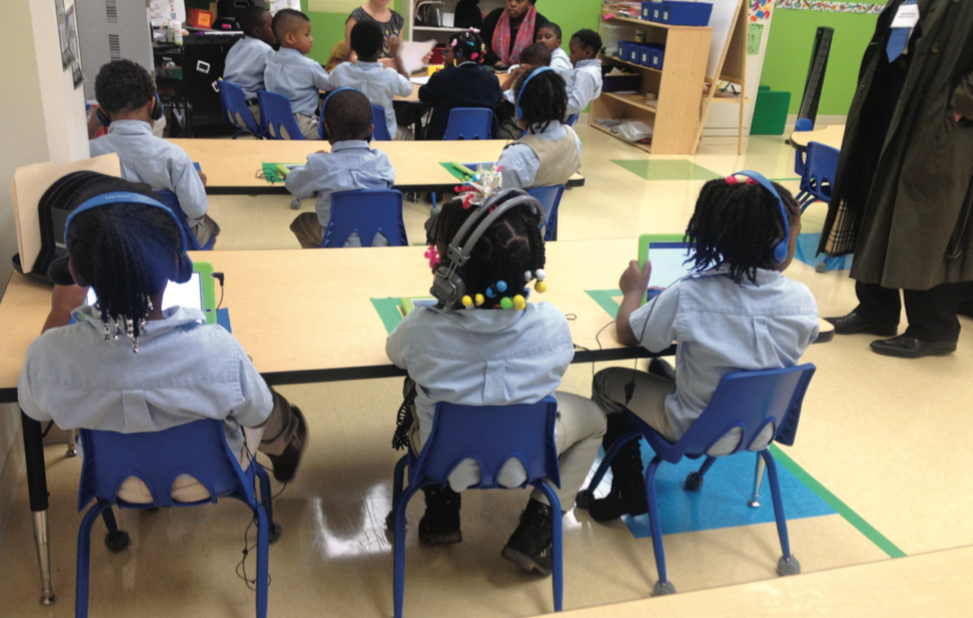
But that’s no longer the case. Moe writes that “Newsela, backed by Kleiner Perkins and Mark Zuckerberg, builds literacy skills with a publishing platform that automatically tailors news articles to a user’s reading level. Acrobatiq, a recent spinout from Carnegie Mellon, has developed adaptive courseware based on a decade of research from the university’s pioneering Open Learning Initiative.”[42]
Unfortunately, we in the education reform policy community have turned a blind eye to these innovations and more customized solutions, instead focusing on creating more uniform schools, to ensure more predictable outcomes. To minimize alleged risk, we are now driven to embrace only those new institutions that are created and managed by familiar, “proven” entities. Such an approach to scale not only threatens the education reform movement’s very existence, but it ignores the changing character of rank-and-file teachers. A growing number of our educators are younger and more liberal-minded. They actually agree with most of the fundamentals of education reform — flexibility, diversity and innovation. Lest we forget, the pioneers of our movement worked in traditional school systems. They are not and never were the adversary.
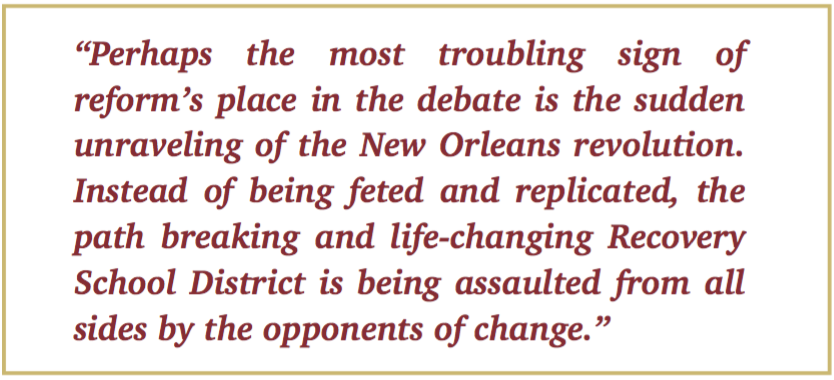
Let’s be clear — some substantial progress has been made. But with all the people, money and expanded awareness we have created in 25 years, we can and must do more. Much more. Today there exists a world of education technologists and entrepreneurs who are developing new and varied approaches to teaching, managing, leading and learning on a minute-by-minute basis. We also know more now than ever about how the brain functions, what kinds of learning environments work best for individual students, and how non-cognitive attributes can determine a student’s trajectory in life.
Unfortunately, we are not making enough use of the research and resources and our circle is too small. Our focus on education reform policy and its opponents has obscured our focus on the original target customers — kids and families. Instead, we have become fixated once again on the institutions and the rules and regulations that govern them — having a micro focus when the situation demands macro thinking.
In Clayton Christiansen parlance, the disruptive innovation that resulted from new entrants to the market was a challenge to the incumbents and displaced their dominance — for a time.[43] Today the incumbents have reemerged as dominant forces, largely because the growth of the disrupters have been limited and constrained. The ability for such disruptions therefore to expand and influence the dominant firms has slowed. Without constantly fueling innovation, better-resourced incumbents have no compelling reason to respond.

How Do We Get There? The New Opportunity Agenda
Our reform community has grown. So too has the diversity of viewpoints and to some extent agendas. To reset this movement, we believe it’s necessary start with common ground. Specifically, the twin values of opportunity and upward mobility.
Speaker Paul Ryan’s May 2016 agenda from the Task Force on Poverty, Opportunity, and Upward Mobility cites dwindling prospects for Americans hoping to lift themselves out of poverty and to achieve the American Dream. “34% of Americans raised in the bottom fifth of the income scale are still stuck there as adults … In that sense, Americans are no better off today than where they were before the War on Poverty began in 1964.”[44]
To end this cycle, we must turn to policies with proven positive impacts on upward mobility. Speaker Ryan’s report draws needed attention to the role that parent empowerment plays in finding the best educational options for kids. He applauds the DC Opportunity Scholarship Program for arming parents with choice, and allowing students to enroll in a program that graduates 26% more DC students than traditional public schools and places 90% of its graduates on the path to college.[45] In the wake of the 2008 financial crisis, it is more important than ever that students from all zip codes are equipped with the chance to succeed through college and into the workforce.
President Obama also has championed the success that innovative schools of choice have had educating students who would otherwise be stuck in failing schools. Speaking to graduates of the Mapleton Expeditionary School of the Arts in Thornton, CO, President Obama congratulated them on the achievement of taking a school with a 50% college matriculation and turning it into a 100% acceptance rate in only three years. He held this up as an “example of what is possible in education if we’re willing to break free from the tired thinking and political stalemate that’s dominated Washington for decades, if we’re willing to try new ideas and new reforms based not on ideology but on what works to give our children the best possible chance in life.”[46] His education department’s leadership has often been uniquely focused on innovation and technology and is enormously welcoming of input from people from all vantage points.
Improved educational outcomes require innovation and opportunity throughout the education landscape. It is time to offer freedom to those who want to engage in real innovation — freedom from burdensome regulations, yes, but also freedom to disrupt and engage new models and modalities. We need to look to the basic principles that started a generation of reform and break bad habits. We have been cowed by inaccurate media coverage of school reform. We have been lulled into accepting incremental change by our legislators and our lobbyists. And we often accept bureaucracy and rules as a substitute for judgment and freedom.
Yet parents everywhere want choices and diverse learning approaches. Teachers in every kind of school want autonomy and welcome accountability. And a new generation of educators is restless and ready to engage. We can create collaborations with new parties and organizations to bring about historic change. From the ed-tech entrepreneurs in Silicon Valley to leaders of investment and higher education communities, we have the opportunity to forge partnerships across the for-profit and non-profit sectors as well as across political boundaries.
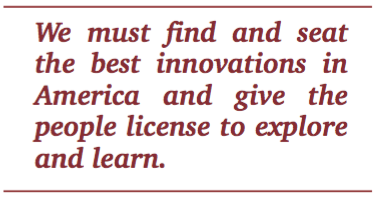
We must find and seat the best innovations in America and give the people license to explore and learn. We must define accountability as learning, and find wholly new and meaningful ways to measure actual progress. We must carve opportunities to match each student’s own needs with the institutions or learning environments that might best serve them. To do all of this, we must ensure that money is available to fund students wherever they are, and that all of our work and policies are highly transparent, understandable and meaningful.
It is time to usher in a New Opportunity Agenda characterized by four core tenets: Innovation, Flexibility, Opportunity and Transparency.
We cannot have innovation without the ability to try new models.
We cannot involve teachers, parents and students without opportunities to make decisions about where and how they teach and learn.
We cannot have opportunity and choice without good information to make decisions.
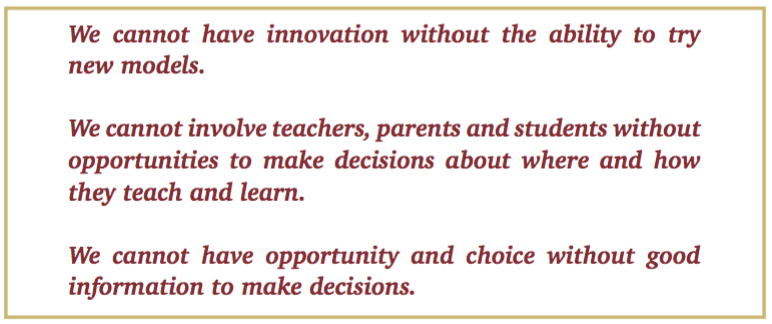
Innovation
This is a country built on innovation, but when it comes to education we are far too cautious. Looking at the nation as a whole, somewhere between 30 and 40% of children can read on grade level. Among African-American and Hispanic youth, that number is closer to between 10 and 18%.[47] Our scores on math and science put us well below most developed countries. The only way out of this hole is through innovation. Looking at these numbers, it’s clear we have nothing to lose.
We need to rethink everything we know about education. On the most basic level, we should be asking: Why are students attending school from September to June as they did when we were an agrarian economy? Why five days a week? Why do they start at 7 am? We should be calling every aspect of education into question: Should we have more students in a class or fewer? Are we using the most effective methods to teach kids how to read? Is the math they learn the math they will need for their careers? Should we group kids by age or by level of knowledge? What about adults lacking literacy: why are programs for adult students separated from broader schooling decisions? With all we know about the impact of non-cognitive skills on progress, and little science validating the connection between age and grades, we must open up the field to powerful approaches to student centric, not grade centric education.
One of the biggest sources of innovation in the education world could come from technology. In addition to allowing for more accurate assessment, so-called blended learning has the potential to offer individually tailored learning plans, even anticipating the areas where a child might be challenged before problems arise.
As reformers we must do everything possible to bring innovative technologies to our schools. Erecting barriers at the local, state or federal level to determine in advance which new ideas will succeed can only slow our progress.
We do not need a thousand flowers to bloom, as the saying goes. What we need is to have a thousand (or tens of thousands) of seeds planted. Those that are watered by parents and students and teachers, with money and time and loyalty, will succeed. The rest will become part of the fertile soil that will make more and better innovations possible in the future.
Flexibility
Our public school leaders have been asking for years for government to remove the handcuffs. They welcome and need the ability to change their operations, and drive a new education culture. Some will take advantage of it, some will not. We should provide incentives for them to do so.
Similarly, the people who want to start new schools need freedom and autonomy and they need a level playing field, particularly when it comes to money. The barriers to starting a school in some states are too onerous. Some of these barriers are widely known. Unlike traditional public schools, for instance, charter schools in most states must pay for their own facilities. This puts them at a tremendous financial disadvantage.
But other regulations are also creating obstacles for new schools. Some states require that new schools only use “proven concepts” for their curricula or their school model. Others require that teachers have a particular kind of certification or even that they have experience starting up other schools before they can be authorized.
Not only would we encourage government to be more flexible, we would also like to see philanthropy do more to think outside the box. Many generous donors have become wed to the idea of “scalable models.” While we understand the desire to solve the nation’s education problems on a large scale, there are many schools out there that are helping a hundred or two hundred kids at a time. We would encourage philanthropists to think about supporting these diamonds in the rough, rather than only supporting the proven concepts or the ones that can replicate themselves quickly.
Opportunity
The best and quickest path to unleash innovation is to follow a consumer model of organization theory, and ensure that money follows the consumer to the product they want — their school of choice. Containing school boundaries by zip code denies children access to educational venues they may never know if they didn’t have the option to explore.
While it is slowing breaking up, the monopoly created by our traditional public education system has led to largely mediocre — and sometimes horrendous — academic outcomes.
We must come together and find consensus over how we spend money. Parental involvement will never be a reality for all parents until they are able to drive their children’s education. When money follows students, whether at a charter school, a traditional neighborhood school, a private school, or even for homeschooling cooperatives or courses at a community college, all parties are more accountable.
While we think there is an important role for accreditors in the process of opening new schools, we believe that those schools that are not performing up to parents’ expectations will close. No accrediting agency has more of an incentive to keep kids out of bad schools than mothers and fathers.
Transparency
In order for parents to exercise choice, they need information. While there has been a great deal of controversy over the content of standardized tests and the frequency at which they are administered, we believe that there needs to be some way of comparing schools and districts across the country. ESSA provides an opportunity to rethink how states and communities seek and reveal student results and school effectiveness.
The National Assessment of Educational Progress (NAEP) remains the gold standard of assessments, offering parents, educators and lawmakers a strong sense of how our children are performing in most subjects, and particularly reading and math. Public agencies need to do a better job of making these scores both accessible and understandable to the public.
Similarly the state-specific standardized tests need to be published online in a way that makes it easy to compare different schools in a particular area. Many states have taken to weighting the data in ways that make an apples-to-apples comparison difficult, if not impossible. Parents cannot make informed decisions if they do not have accurate, clear, and consistent information.
States should benchmark their own tests to the NAEP scores and publicize that information as well, so parents will know how their children are performing not only relative to others in the state, but also to those around the country.
Finally, states need to tell parents how many dollars are being spent on each student. These numbers should include not only the budget for instruction but also for facilities. If the state is not paying for a school building, that should be reflected in the data. Only when this is made clear, will parents and taxpayers understand how much bang they are getting for their bucks.
These principles are important not just for poor students, but also for all people, most notably our children.
Our movement will never be perfectly harmonious, but it can and has been productive. Its strength comes from its uniqueness politically: Forged under Reagan, sharpened under Bush 41, boosted under Clinton, supported by Bush 43, and aided by President Obama. With a presidential election year that promises to challenge and upset even our best successes, we must succeed.

How We Will Do This
After almost a quarter century of leading the fight for expanded educational opportunities for all students, the Center for Education Reform will refocus is efforts on coalescing all involved around the principles in this Manifesto. We are inviting all our allies, former adversaries, and new partners to join hands in a commitment to a new equation for education — Innovation + Opportunity = Results, or Ed Reform I.O, dedicated to advancing the foundational concepts of innovation and opportunity in all future policy efforts. We are committed to educating the media and the public about what it takes to have excellence in education for all students. To that end, we seek to ignite a new conversation with thousands more individuals, organizations, policymakers and activists, and collaborate to achieve success. This is how we plan to start:
We will convene discussions and engage those who support or are simply interested in the concepts put forth in EdReform I.O.
We intend to leverage the media to build momentum, attract new advocates, and work with our partners to solve problems together.
We have launched the Innovation in Opportunity project, an effort to integrate education technology into our schools, getting the best innovations possible tested to ensure the best impact on students and families.
We will work in tandem with colleagues around the country to educate the next Generation of Education Leaders, and Reformers. We must arm them with the historical knowledge necessary to support change.
And we welcome communication and involvement with anyone who, like the Commission behind a Nation at Risk, agrees to set aside major disagreements and agree on the things that they — we — believe are absolutely crucial.

[1] United States. National Commission on Excellence in Education. A Nation at Risk: The Imperative for Educational Reform: A Report to the Nation and the Secretary of Education, United States Department of Education. Washington, D.C.: The Commission, 1983.
[2] The Center for Education Reform. “Dr. Milton Goldberg Ed.D on “A Nation at
Risk” Report: What We’ve Learned and Why It Matters.” Online video clip.
YouTube. YouTube, 5 October 2015. Web. 9 June 2016.
[3] Consoletti Zgainer, Alison and Kara Kerwin. Charter School Laws Across the States: 2015 Rankings and Scorecard. Washington, D.C.: The Center for Education Reform, 2015. p. 6.
[4] The Center for Education Reform. “Dr. Milton Goldberg Ed.D on ‘A Nation at
Risk’ Report: What We’ve Learned and Why It Matters.” Online video clip.
YouTube. YouTube, 5 October 2015. Web. 9 June 2016.
[5] Osborne, David. “How New Orleans Made Charter Schools Work.” Washington
Monthly. Washington Monthly, Aug. 2015. Web. 9 June 2016.
[6] National Alliance for Public Charter Schools. A Growing Movement: America’s Largest Charter School Communities. Washington, D.C.: NAPCS, 2015. p. 4.
[7] Louisiana Scholarship Program. Louisiana Department of Education: Louisiana Believes, n.d. Web. 9 June 2016.
[8] Hawkins, Beth. “Ember Reichgott Junge Confronts Seven Myths and Misconceptions about Charter Schools.” MinnPost. N.p., 17 July 2014. Web. 9 June 2016.
[9] “Charter School Data Dashboard.” NAPCS. National Alliance for Public Charter Schools, n.d. Web. 9 June 2016.
[10] National Alliance for Public Charter Schools. A Growing Movement: America’s Largest Charter School Communities. Washington, D.C.: NAPCS, 2015. p. 4.
[11] Consoletti Zgainer, Alison and Kara Kerwin. Charter School Laws Across the States: 2015 Rankings and Scorecard. Washington, D.C.: The Center for Education Reform, 2015. p. 6.
[12] Ibid. p. 6
[13] “Clinton Signs Charter School Bill.” CNN. Cable News Network, 22 Oct. 1998. Web. 9 June 2016. http://www.cnn.com/ALLPOLITICS/stories/1998/10/22/charter.schools/
[14] “Hillary Clinton Wades into the Internal Democratic Debate over Public Schools.” Editorial. The Washington Post [Washington, D.C.] 11 November 2015: n. pg. Washington Post. The Washington Post. Web. 9 June 2016.
[15] Ibid. Web. 09 June 2016.
[16] “Summary of Hoxby’s ‘How New York Cityʼs Charter Schools Affect Achievement’” (2009): n. pg. The Center for Education Reform, 22 Sept. 2009. Web. 9 June 2016.
[17] Taylor, Kate. “Success Academy Loses in Pre-K Battle With De Blasio Administration.” The New York Times. The New York Times, 26 February 2016. Web. 10 June 2016.
[18] The Editorial Board, NOLA.com | The Times-Picayune. “Legislature Shouldn’t Undermine Charter School Progress in Louisiana: Editorial.” NOLA.com. N.p., 10 Apr. 2016. Web. 9 June 2016.
[19] Mead, Sara, Ashley LiBetti Mitchell, and Andrew J. Rotherham. “The State of the Charter School Movement.” (n.d.): n. pag. Sept. 2015. Web. 9 June 2016.
[20] “School Reform Act.” District of Columbia Public Charter School Board. N.p., 1995. Web. 9 June 2016.
[21] Consoletti Zgainer, Alison and Kara Kerwin. Charter School Laws Across the States: 2015 Rankings and Scorecard. Washington, D.C.: The Center for Education Reform, 2015. p. 92.
[22] “Text: George W. Bush’s Speech to the NAACP.” Washington Post. The Washington Post, 10 May 2000. Web. 9 June 2016.
[23] United States. Department of Education. Institute for Education Sciences. NAEP Nations Report Card: National Assessment of Educational Progress: NAEP. National Center for Education Statistics, n.d. Web. 10 June 2016.
[24] “NC Supreme Court Says Vouchers Are Constitutional: WRAL.com.” WRAL.com. N.p., 23 July 2015. Web. 10 June 2016.
[25] Prothero, Arianna. “Washington Lawmakers Pass Bill to Restore the State’s Charter Schools.” Education Week. N.p., 10 Mar. 2016. Web. 10 June 2016.
[26] “America’s Attitudes Toward Education Reform: Executive Summary.” The Center for Education Reform. N.p., 2013. Web. 10 June 2016.
[27] Massachusetts. Department of Elementary and Secondary Education. State Estimates 34,000 Students Remain on Charter School Waitlists. Massachusetts Department of Elementary and Secondary Education. N.p., 18 Feb. 2016. Web. 10 June 2016.
[28] New Mexico Code 22 Public Schools, § 22-8B (2015). Web.
[29] Idaho Code 33 Education, 331§ 52-5203 (2016). Web.
[30] Charter School Program Act of 1995, N.J.S.A. P.L. 1995 c. 426. Stat 18A:36A. 11 Jan 1996. Web. 10 June 2016.
[31] Tennessee Code 49 Education, § 13-111 (2016). Web.
[32] North Carolina Code 115C Elementary and Secondary Education, § 115C-218 (2016). Web.
[33] “IMPACT: An Overview.” District of Columbia Public Schools, 2016. Web. 10 June
[34] U.S. Department of Education, National Center for Education Statistics, Common Core of Data, “Public Elementary/Secondary School Universe Survey,” 1999-2000 through 2012-13.
[35] “Theory of Change.” Education Evolving. N.p., n.d. Web. 10 June 2016.
[36] Kolderie, Ted. The Split Screen Strategy. Edina: Beaver’s Pond, MN. Print.
[37] Tocqueville, and Arthur Goldhammer. Democracy in America. New York: Library of America, Distributed to the trade in the U.S. by Penguin Putnam, 2004. Print.
[38] Khan Academy. N.p., n.d. Web. 10 June 2016.
[39] Kolderie, Ted. The Split Screen Strategy. Edina: Beaver’s Pond, MN. Print.
[40] Moe, Michael. “This Is What Will Happen When Education Catches Up With Modern Technology.” OZY. N.p., 12 Dec. 2015. Web. 10 June 2016.
[41] Ibid.
[42] Ibid.
[43] “About Us.” Christensen Institute. N.p., n.d. Web. 10 June 2016.
[44] United States. U.S. House of Representatives. Speaker of the House-Policy, Opportunity, and Upward Mobility Task Force. A Better Way: Our Vision for a Confident America. N.p.: n.p., 2016. Print.
[45] United States. Department of Education. National Center for Education Evaluation and Regional Assistance. Evaluation of the DC Opportunity Scholarship Program. N.p.: n.p., n.d. Web. 10 June 2016.
[46] “Full Text of Obama’s Education Speech.” The Denver Post. N.p., 28 May 2008. Web. 10 June 2016.
[47] United States. Department of Education. Institute for Education Sciences.NAEP Nations Report Card: National Assessment of Educational Progress: NAEP. National Center for Education Statistics, n.d. Web. 10 June 2016.

